This Saturday's story time book is The Tree Book for Kids and Their Grown Ups written and illustrated by Gina Ingoglia.
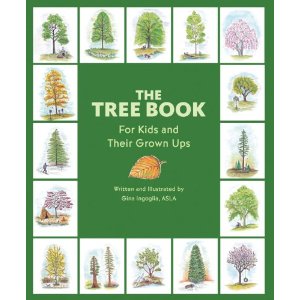
The Tree Book is a great introduction to trees and tree identification for kids. The information, very much like the illustrations, is clear and detailed without being overwhelmingly exact or technical. The book is as pretty as it is scientific and I like that about it.
The book begins with an invitation to get to know trees a little better. (Click for a larger version.)
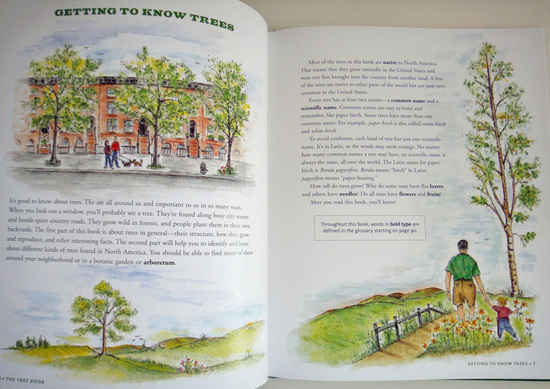
Ingoglia tells kids (and their grownups) that it's good to know about trees. She tells us she'll help us discover some of their names, why some have flat leaves and others needles, and how tall they grow. She puts any science-y words in bold and includes them in a glossary in the back of the book so you can look them up if you need to. And she includes pictures of people enjoying trees and nature. You can tell that we're not going to be looking at tree parts in microscopes here; we're going to be looking at them the way that any child could look at and experience them.
The first 20 pages answer a few questions about trees, such as how they eat and drink, what kind of leaves they have and why they change color.
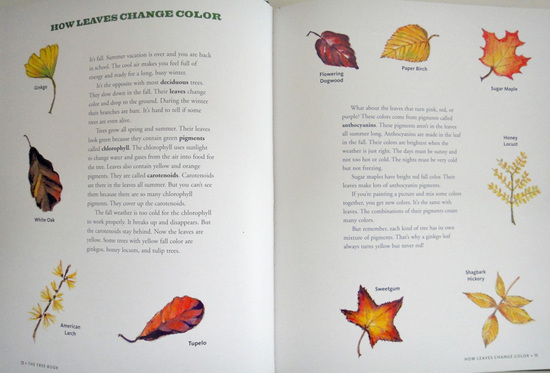
She talks about flowers, fruit, and cones and suggests we go bark scouting to examine this often overlooked, but very interesting part of a tree. And she includes some tips for identifying trees in winter (something I could have used back in Februrary!).
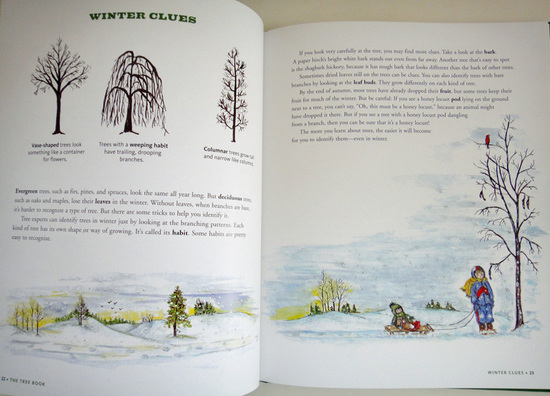
The rest of the book describes 32 common trees in North America. Each species gets a lovely two-page spread, including drawings of the tree, its leaves, buds, flowers and fruit. These tree id books often go through tree types alphabetically, which means that my ash tree is usually first.
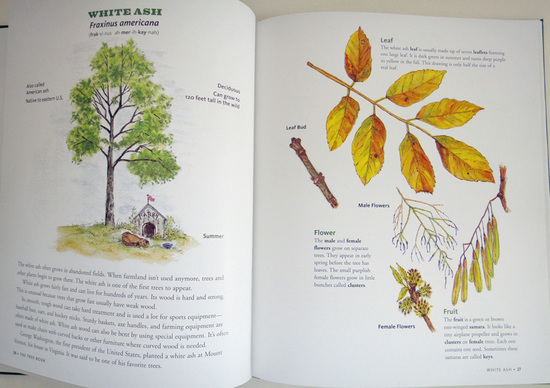
And the honey locust, which I now know is the tree that makes the crazy long seedpods we always see on our walk to school!
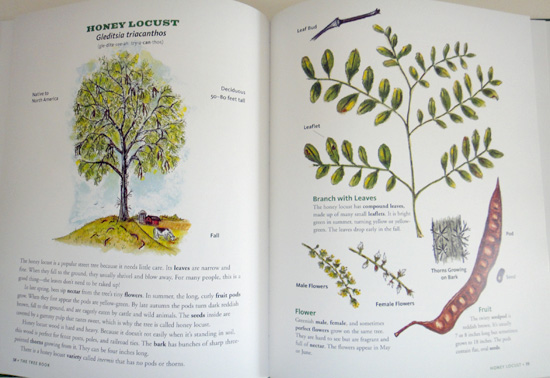
There's the magnolia, whose amazing flowers we saw just this week.
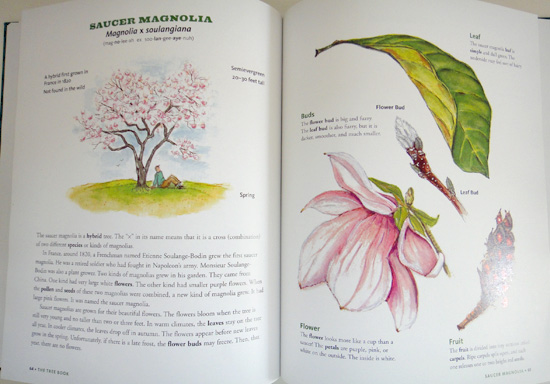
And the gorgeous sugar maple - a very common tree around here.
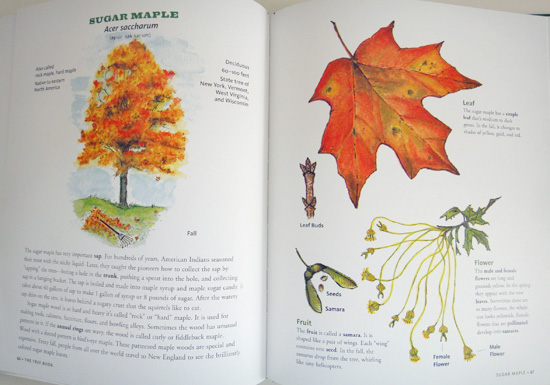
Well, I'm sure you can tell that I could look at these pictures all day. Every one of these pages seems to convey something special or welcoming about the tree. I want to study them all and then search for them outside!
I've stumbled across a couple more kid-friendly tree id books. First, My Favorite Tree: Terrific Trees of North America , which also details many varieties of trees found in North America and shows kids outside playing and relaxing under trees. Here's my ash tree right up front again.
, which also details many varieties of trees found in North America and shows kids outside playing and relaxing under trees. Here's my ash tree right up front again.
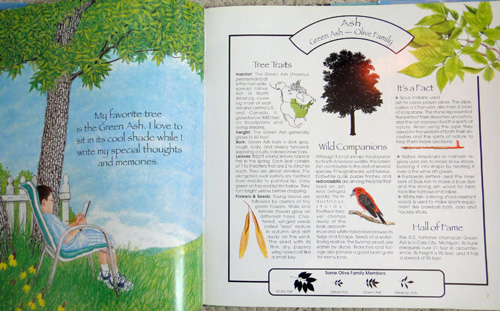
Another good book to check out is Tell Me, Tree: All About Trees for Kids, which is directed at even younger children. It describes how trees grow and shows some of their flowers and leaves and even includes some tree watching activities that kids could do at home or in a classroom.
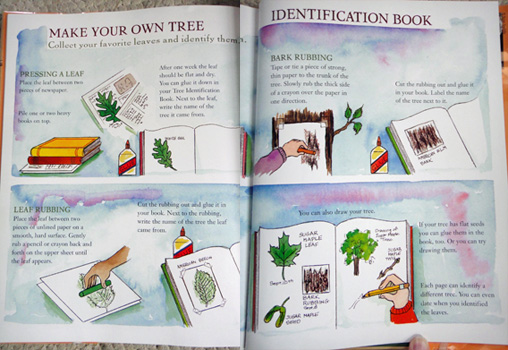

Okay, no more reading now. Time to get on out there and look at some trees! Or, just take another look out your window. Now tell me, what kind of tree is that?

The Tree Book is a great introduction to trees and tree identification for kids. The information, very much like the illustrations, is clear and detailed without being overwhelmingly exact or technical. The book is as pretty as it is scientific and I like that about it.
The book begins with an invitation to get to know trees a little better. (Click for a larger version.)

Ingoglia tells kids (and their grownups) that it's good to know about trees. She tells us she'll help us discover some of their names, why some have flat leaves and others needles, and how tall they grow. She puts any science-y words in bold and includes them in a glossary in the back of the book so you can look them up if you need to. And she includes pictures of people enjoying trees and nature. You can tell that we're not going to be looking at tree parts in microscopes here; we're going to be looking at them the way that any child could look at and experience them.
The first 20 pages answer a few questions about trees, such as how they eat and drink, what kind of leaves they have and why they change color.

She talks about flowers, fruit, and cones and suggests we go bark scouting to examine this often overlooked, but very interesting part of a tree. And she includes some tips for identifying trees in winter (something I could have used back in Februrary!).

The rest of the book describes 32 common trees in North America. Each species gets a lovely two-page spread, including drawings of the tree, its leaves, buds, flowers and fruit. These tree id books often go through tree types alphabetically, which means that my ash tree is usually first.

I'm not convinced I have a white ash (there are also green ones), but I'm thinking my tiny blooming purple flowers could totally end up looking like those in the drawing. I'll share more thoughts on this another time. Let's move on to some more trees!
Next up, the elm, like the Olmstead Elm and the Madison Square Park elm I've written about on this blog.
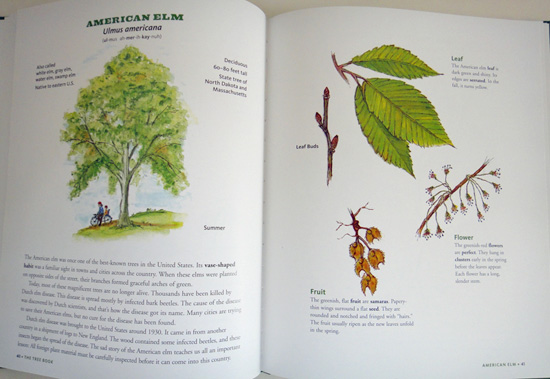
Next up, the elm, like the Olmstead Elm and the Madison Square Park elm I've written about on this blog.

And the honey locust, which I now know is the tree that makes the crazy long seedpods we always see on our walk to school!

There's the magnolia, whose amazing flowers we saw just this week.

And the gorgeous sugar maple - a very common tree around here.

Well, I'm sure you can tell that I could look at these pictures all day. Every one of these pages seems to convey something special or welcoming about the tree. I want to study them all and then search for them outside!
I've stumbled across a couple more kid-friendly tree id books. First, My Favorite Tree: Terrific Trees of North America

Another good book to check out is Tell Me, Tree: All About Trees for Kids, which is directed at even younger children. It describes how trees grow and shows some of their flowers and leaves and even includes some tree watching activities that kids could do at home or in a classroom.

Okay, no more reading now. Time to get on out there and look at some trees! Or, just take another look out your window. Now tell me, what kind of tree is that?
